Prices in AUD. Shipping worldwide. Flat rate $8 postage per order within Australia. International by weight calculated at checkout. Read full terms.
-
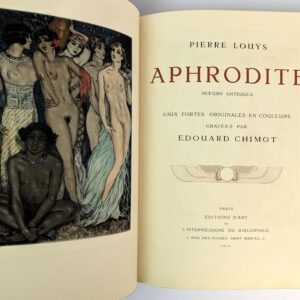

Aphrodite: Moeurs antiques
AU$1,500.00 Read MoreAdd to cartPierre Louys; Edouard Chimot
Paris: Edition d’Art de L’Intermediaire du Bibliophile, 1929.The first edition with illustrations by Chimot of Louys’ immensely successful novel of tumultuous love and desire set in Alexandria. One of 154 copies of the standard edition (from the total edition of 300), this copy finely bound by Herbillon-Crombe.
-
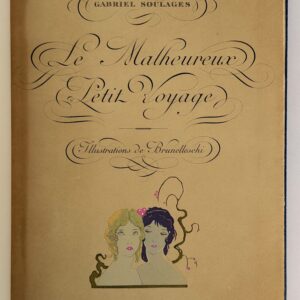

Le Malheureux Petit Voyage
AU$1,000.00 Read MoreAdd to cartGabriel Soulages; Umberto Brunelleschi
Paris: L’Estampe Moderne, 1926.The Unhappy Little Journey, or the Miserable End of Madame de Conflans, Princess of La Marsaille, Reported by Marie-Toinon Cerisette, Her Faithful and Devoted Servant. The first novel by French writer Gabriel Soulaes (1876-1930), and the first edition with romantically erotic illustrations by Italian painter Umberto Brunelleschi. The 27 pochoir illustrations are finely executed, the colour bursting from the page. One of 20 hors commerce copies identical to the standard edition of 434 copies from a total edition of 500 copies, of which this is number VIII, bound in an elegant blue full leather binding with the original wrappers front panel (with pochoir illustration) and spine bound in.
-
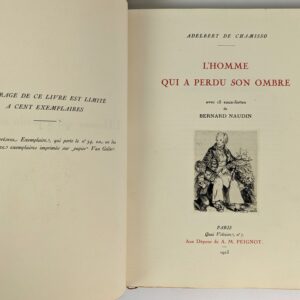
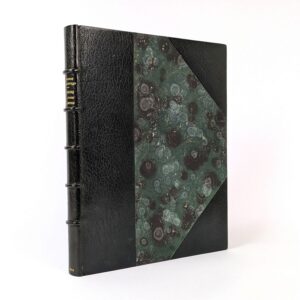
L’Homme qui a perdu son Ombre
AU$1,200.00 Read MoreAdd to cartAdelbert de Chamisso; Bernard Naudin
Paris: A. M. Peignot, 1913.French translation from the original German of Peter Schlemihls wundersame Geschichte (English: The Man with No Shadow) by the exiled French aristocrat, poet, and botanist, Adelbert von Chamisso (1781-1838). The story follows Peter Schlemihl who sells his shadow to the Devil for infinite money. The first edition with 15 engravings by French artist Bernard Naudin (1876-1946) limited to 100 numbered copies, this being one of 75 copies on Van Gelder paper, in a signed fine binding by Bernasconi with the original wrappers bound in. Peter Schlemihl was Naudin’s first major project after giving up painting to devote himself exclusively to printmaking.
-
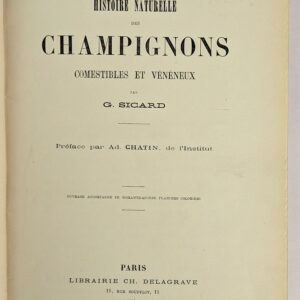
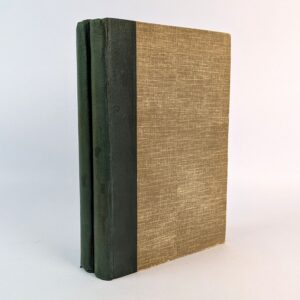
Histoire Naturelle des Champignons Comestibles et Veneneux
AU$1,000.00 Read MoreAdd to cartG. Sicard
Paris: Librairie Ch. Delagrave, 1883.Natural History of Edible and Poisonous Mushrooms by Guilleaume Sicard. Rebound in plain cloth with the plates in a second volume. VOLBRACHT 1981.
-


Histoire des Champignons, Comestibles et Veneneux, .. Avec un Atlas
AU$1,800.00 Read MoreAdd to cartJoseph Roques
Paris: Chez Fortin, Masson et Cie, 1841.[History of edible and poisonous mushrooms, decorated with colored figures representing the main species in their natural dimensions; where we expose their distinctive characteristics, their nutritional and economic properties, their harmful effects and the means of guaranteeing or remedying them, a useful work for mushroom lovers, doctors, naturalists, rural owners, mayors of cities and countryside, etc.] The second edition of one of the most important (and beautifully illustrated) early works on edible wild mushrooms and fungi in France. VOLBRACHT 1793.2. The atlas with 3 additional colour plates (1 folding) from two other works bound in at the beginning.
-
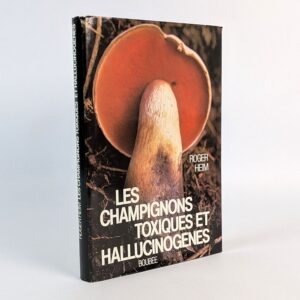
Les Champignons Toxiques et Hallucinogenes
AU$150.00 Read MoreAdd to cartRoger Heim
Paris: Societe Nouvelle des Editions Boubee, 1978.Toxic and Hallucinogenic Mushrooms. Published with the assistance of the National Centre for Scientific Research. The Second Edition, completely revised and expanded.
-
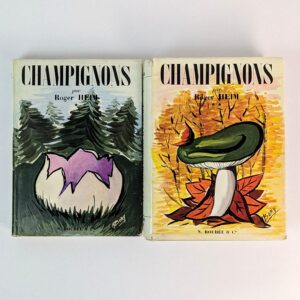

Les Champignons d’Europe
AU$125.00 Read MoreAdd to cartRoger Heim
Paris: Editions N. Boubee & Cie, 1957.First editions in the illustrated jackets by Michelle Bory of Heim’s major work on the mushrooms of Europe. This copy with the bookplate of Dr. Jean Mennerat in volume 1.
-

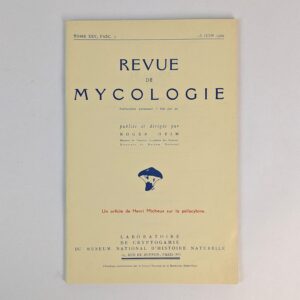
La Psilocybine (Experiences et autocritique): Revue de Mycologie Tome XXV, Fasc 1, 15 Juin 1960
AU$200.00 Read MoreAdd to cartRoger Heim; Henri Michaux
Paris: Laboratoire de Cryptogamie du Museum National d’Histoire Naturelle, 1960.Single number of the Revue de Mycologie with a feature article by Henri Michaux on psilocybin.
-
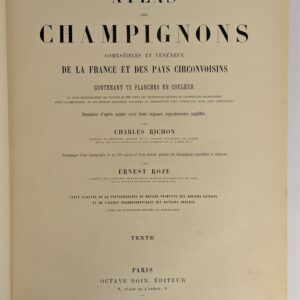
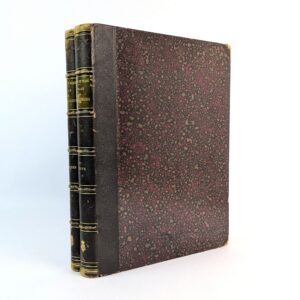
Atlas des Champignons Comestibles et Veneneux de la France et des pays Circonvoisins
AU$2,500.00 Read MoreAdd to cartCharles Richon; Ernest Roze
Paris: Octave Doin, 1888.Atlas of edible and poisonous mushrooms of France and surrounding countries containing 72 color plates or figures of 229 types of the main species of mushrooms sought for food, and similar suspect or dangerous species with which they are confused drawn from nature with their reproductive organs amplified by Charles Richon… Accompanied by a monograph of these 229 species and a general history of edible and poisonous mushrooms by Ernest Roze… Text illustrated with 62 photoengravings of primitive drawings by old authors and organographic figures by recent authors after reproductions made by Charles Rolet. Key late 19th century work of French mycology. VOLBRACHT 1753. BITTING pg. 398. This copy with the bookplate of French mycologist Raymond Bertault.
-


L’Erotomanie: Illusion Delirante d’Etre Aime
AU$1,000.00 Read MoreAdd to cartGaston Ferdiere
Paris: G. Doin & Cie, 1937.Study of erotomania by French psychiatrist Gaston Ferdiere (1907-1990). Ferdiere was close to a number of the Surrealist circle of artists and was the head of psychiatry at the asylum where Antonin Artaud underwent electroshock therapy. This copy inscribed by Ferdiere to the French artist Georges Hugnet, also with a manuscript letter from Ferdiere to Hugnet with the original postmarked envelope and the original prospectus laid in.
-
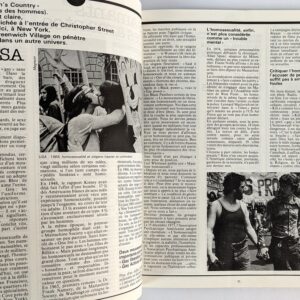
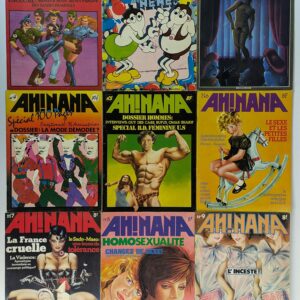
Ah! Nana (Complete Set, 9 Issues)
AU$1,200.00 Read MoreAdd to cartJanic Guillerez; Marjorie Alessandrini; Anne Delobel; et al.
Paris: Les Humanoides Associes, 1976-1978.Complete set of the French women’s comic magazine Ah ! Nana which evolved out of and was published by the comic book publishing house of Moebius (Jean Giraud), Jean-Pierre Dionnet, Philippe Druillet, and Bernard Farkas, Les Humanoides Associes. During a staff lunch of their magazine Metal Hurlant (the original of the English adaptation Heavy Metal), Jean-Pierre suggested to the women present (including his wife Janic Guillerez who became chief editor of Ah! Nana) to create a women’s magazine and feminist newspaper. Ah!Nana ran for nine issues, each with its own theme, coming to a short end following the magazine being banned to minors after the publication of the eighth issue devoted to homosexuality. This led the editorial team to go all in on the ninth and final issue, devoting it to incest, leading to the French censorship Commission banning the publication, labelling it pornographic.
-
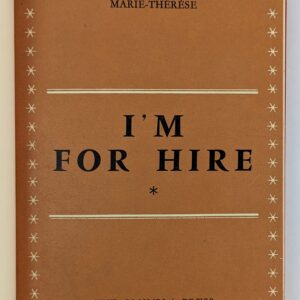
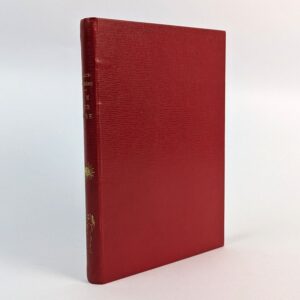
I’m For Hire
AU$500.00 Read MoreAdd to cartMarie-Therese
Paris: Olympia Press, 1955.First-person account of a Parisian prostitute working all sides of WWII. Translated from the French, Vie d’Une Prostituee, later titled The Memoirs of a Prostitute. KEARNEY 17.
-

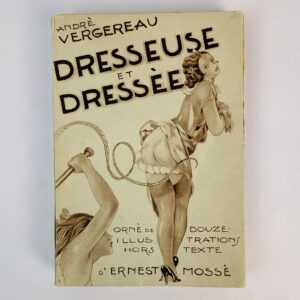
Dresseuse et… Dressee
AU$650.00 Read MoreAdd to cartAndre Vergereau; [Umberto Brunelleschi]
Paris: Aux Editions Prima, 1939.French flagellation novel with 12 plates by d’Ernest Mosse, a pseudonym for Italian illustrator Umberto Brunelleschi who had been residing in Paris since 1900 and among his works designed numerous costumes for Josephine Baker.
-
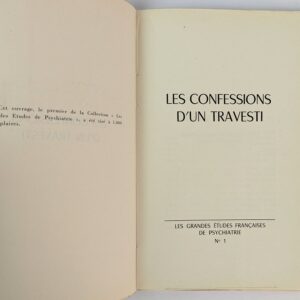
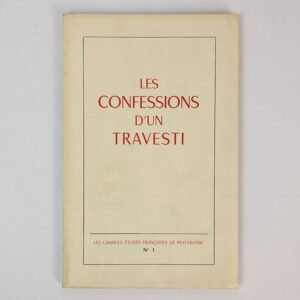
Les Confessions d’un Travesti
AU$150.00 Read MoreAdd to cart[Eric Losfeld]
Paris: Le Terrain Vague, 1956.Les Grandes Etues Francaises de Psychiatrie No. 1, an aggrandizing imprint and seemingly a once-off published by Eric Losfeld’s Le Terrain Vague imprint. Autobiographical psycho-social confessions of a 43 year old married heterosexual male cross-dresser and female underwear fetishist. Illustrated with 5 photographic plates of the author in various states of undress.
-
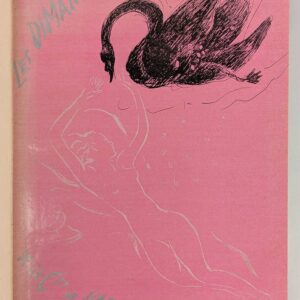
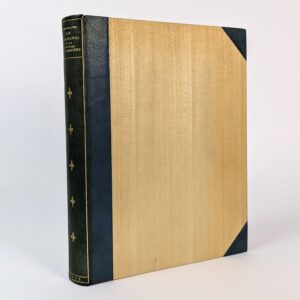
Les Dimanches de la Comtesse de Narbonne
AU$200.00 Read MoreAdd to cartDaisy Fellowes; Vertes
Paris: Editions de France, 1935.Novel of Parisian high society in the early 20th century by the French socialite Daisy Fellowes, Paris editor of American Harper’s Bazaar and heiress to the Singer sewing machine fortune. Illustrated by Marcel Vertes. Neatly rebound in half leather and wood preserving the original pink wrappers.
-
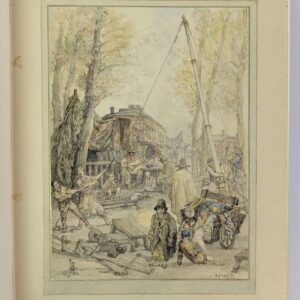
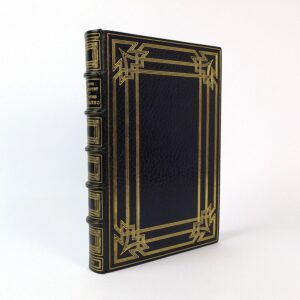
Les Freres Zemganno
AU$3,000.00 Read MoreAdd to cartEdmond de Goncourt; Auguste Brouet
Paris: Edite par F. Gregoire, 1921.Goncourt’s Naturalist exploration of the evolution of French literature through the acrobatic artistry of two circus brothers, also echoing and exploring his own love and loss of his inseparable brother (and literary partner) who passed some years prior. Originally published in 1879, here for the first time with numerous illustrations by Auguste Brouet. The illustrations include 15 full page etchings, a half-page etching on the half-title, and a vignette on the title, all signed in the plate, together with a further 51 illustrations in the text. This copy extra illustrated with 4 original signed drawings by Brouet mounted at the beginning, and finely bound in a signed full leather binding by Ganape, RD, dated 1925, and with the bookplates of Yvan Lamberty and B. Le Dosseur.
-
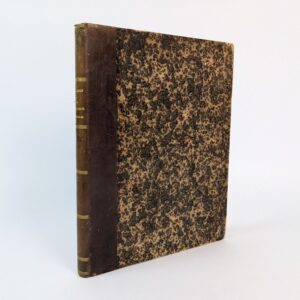
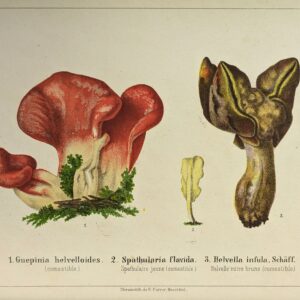
Les Champignons Comestibles et les especes veneneuses avec lesquelles ils pourraient etre confundus
AU$1,200.00 Read MoreAdd to cartLouis Favre-Guillarmod
Paris: Librairie Agricole, [1869].Edible and poisonous mushrooms in the Canton of Neuchatel, Switzerland. The first complete edition with the 2 parts in 1 volume. The first part being a reprint of the 1861 edition, Les champignons comestibles du canton de Neuchatel, the second with a new introduction and further invaluable information on the edibility of mushrooms VOLBRACHT 586. This copy with the mycological bookplate of Jacques and Helene Bon.
-
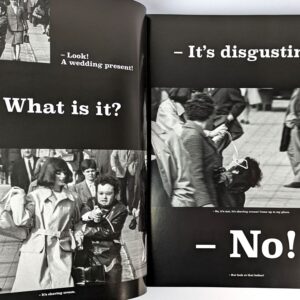
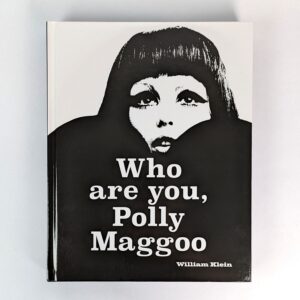
Who are you, Polly Maggoo
AU$80.00 Read MoreAdd to cartWilliam Klein
Paris: delpire & co, 2023.Photo-novel based on Klein’s 1966 film.
-
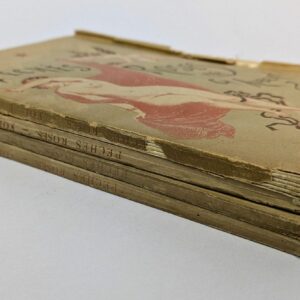
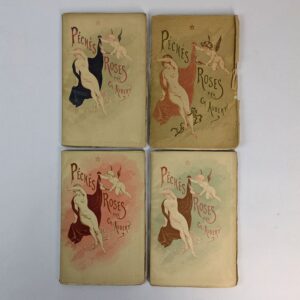
Peches Roses (4 Volumes, I-IV)
AU$200.00 Read MoreAdd to cartCharles Aubert
Paris: Chez Tous Les Libraires, 1884.The first 4 short erotic and love stories by Charles Aubert published under the Peches Roses title in the original illustrated wrappers with a nude woman revealed by a cherub. Each with an engraved frontispiece by Jules-Armand Hanriot signed Jul. Hanriot, also title vingette and an illustrated headpiece. Full list of titles: I. Le Sabbat; II. Les Scelles; III. Le Premier Voyage; IV. Le Chien Volant.
-

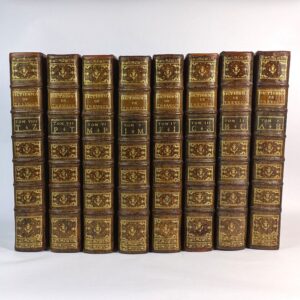
Dictionnaire Universel Francois et Latin, Vulgairement Appele Dictionnaire de Trevoux (8 Volumes)
AU$5,000.00 Read MoreAdd to cart[Dictionnaire de Trevoux]
Paris: Compagnie des Libraires Associes, 1771.The final and most comprehensive edition of the Dictionnaire de Trevoux, so nicknamed because of its original publication in the town of Trevoux. The original 1704 edition, assumed to be directed by the Jesuits, was largely derived from the 1701 edition of Antoine Furetiere’s 1690 Dictionnaire universel. From the much expanded second edition it became widely used and was a major inspiration for Ephraim Chamber’s 1728 Cyclopaedia and the 1751-72 Encyclopedie, ou dictionnaire raisonne des sciences, des arts et des metiers.
